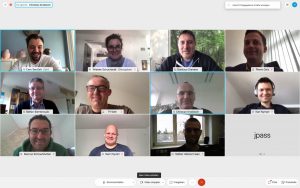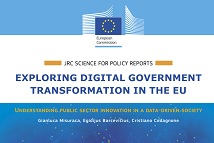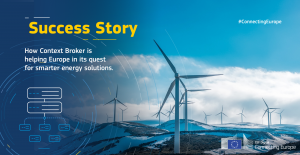Enabling digital competences – improving digitization powered by people
Goals of the association
Afterwards, the board of Ideasforum e.V., Gianluca Dianese, Pierre Golz and Wiebke Schuchardt, introduced themselves, the concept as well as the goals of the association. To promote the digitalization of society and the economy, the association wants to support new forms of networking. The goal of the forum is to jointly shape digitization and urban development in a citizen-oriented manner. The registered association is to play a central role in the realization of “smart cities” and in promoting voluntary commitment to the digitization of cities. True to the association’s motto “Powered by People,” the aim is to promote communication and collaboration with citizens and companies, to foster virtual test environments to support projects, and to enable the transfer of knowledge, also and especially between municipalities. The focus here is always on knowledge transfer using so-called open source technologies. The association’s goal is to promote innovations in digitization and other related fields of technology and make them accessible to the general public. The aim is to shape the digitization of cities, society and the economy together with citizens in Ideasforum e.V. – for livable cities.Project ideas in workshops
To this end, the first potential project ideas were presented to those present in three small workshops: 1. once upon e-time – digital education and art with Gianluca Dianese 2. smart energy – shaping the energy turnaround in the neighborhood with citizens with Dr. Markus Mirz – RWTH Aachen, Fraunhofer Institute Aachen 3. sustainability in cities and how digitalization can support this with Thomas Semmelmann, City of Herne. At the very beginning, the members agreed to become visible with concrete projects. Therefore Ideasforum e.V. invited many stakeholders from the education sector to discuss digital education offers and to present a first project idea called “Once upon e-Time”. Here, Dr. Mölders from the LWL Museum of Archaeology offered to make the museum available to interested young people as a real laboratory. The project aims to promote the learning of digital skills and media in a practical way by creating videos and knowledge platforms with pupils based on the current Stonehenge exhibition of the LWL Museum of Archaeology Herne, which will be disseminated internationally. Following the event, the Forum still held its ordinary general meeting. The association decided to join the initiative Living-in.EU. This is a European approach to the promotion of sustainable cities and communities of the future, in which, true to the motto of the association, the citizens are at the center of project and urban development.The Ideasforum becomes a registered association
On 30.6.2021 it is going to happen! With the support of the city of Herne and umagine GmbH the Ideasforum becomes a registered association! Founding members are Gianluca Dianese (Ideasforum), Wiebke Schuchardt (Ideasforum),Dr. Frank Dudda (City of Herne), Pierre Golz (City of Herne), Sven Schuchardt (Umagine GmbH), Cem Sentürk (Umagine GmbH), Prof. Dr. Wolfgang Schuster (Institute for Sustainable Urban Development), Prof. Dr. Antonello Monti (RWTH AACHEN), Ulrich Ahle (FIWARE Foundation), Christoph Reitenberger (City of Dormagen), Andreas Haug (City of Göppingen).
We are looking forward to many active members!
Taking off thanks to digitization

On June 23, the Digital Herne Business event “Durchstarten Dank Digitalisierung” will take place. Gianluca Dianese will speak here as a panelist on the topic of “Smart People City Herne” and IDEASFORUM e.V. – Shaping the Smart City Herne together”.
To learn more about this event, click here: http://digital.herne.business/
OPEN DEI Energy – Working Group “Data Exchange and Architectures”
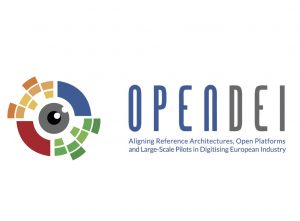
Don’t miss our next event on Open DEI Energy on May 19th at 15.00! We will highlight the main approaches, objectives and achievements of those working groups & projects, part of the OPEN DEI initiative and focused on Data exchange in the Energy domain.
to find out more or register click here
Digital citizen participation with DIPAS available as open source software now
The digital participation system DIPAS, which was developed in Hamburg, has been available as open source software for subsequent use and joint further development since the end of February 2021.
DIPAS was developed as part of a three-year research and development project by the Hamburg Authority for Urban Development and Housing (BSW), the State Office for Geoinformation and Surveying (LGV), and the CityScienceLab (CSL) of HafenCity University, and was released as open source software in February 2021 during a conference to mark the end of the project. The system for informal citizen participation procedures was developed step by step and with several test loops in real participation procedures between 2017 and 2020 and evaluated during the project.
For more information read here https://urban-digital.de/digitale-beteiligung-dipas/?utm_source=newsletter&utm_medium=email&utm_campaign=digitale_stadtentwicklung_maerz_2021&utm_term=2021-03-17
LFEnergy Spring Summit Registration is now open!
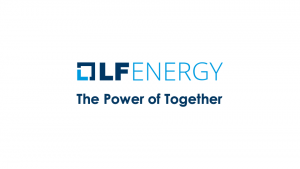
2021 is the beginning of an extraordinary decade of power system transformation leading to the electrification of everything. On April 14, 2021 you can join LF Energy for this Spring Summit showcasing collaborative development and shared innovation to accelerate the energy transition through open source and software-defined infrastructure.
To find our more or to register click here.
SmartCitiesWorld and FIWARE Foundation announce partnership
SmartCitiesWorld has entered into a media partnership with FIWARE Foundation to support its initiatives that seek to solve urban challenges and support the wider smart digital ecosystem.
For Details click here.
Open Call for engagement in ICT Standardisation
The StandICT.eu 2023 initiative recently published Open call #2 for engagement in ICT Standardisation. This could be an interesting funding opportunity for your members!
The project launches a series of 10 Open Calls spanning across a 3-years timeline, providing 3 million Euro through a cascade grant process to support participation of over 400 European standardization specialists for their contributions in the key international and global SDOs and standards consortia.
To find out more click here.
FIWARE Energy DAY – Edition 2
For the last few years, FIWARE Foundation has been supporting local energy communities, utilities, and energy services providers in pursuing innovation, and with the second edition of the FIWARE Energy DAY, it is aiming to present new achievements and opportunities thanks to a programme featuring world-renowned speakers and experts, showcasing a series of exciting case studies demonstrating how easily local energy communities can develop and integrate new, innovative services in the grid.
To register click here.
FIWARE Context Broker: The engine for future energy systems
Gianluca Dianese has published a very insightful article on how the FIWARE generic enablers have accelerated the development of a “micro grid services” solution. The project has delivered many benefits such as assessing the real impact of “System of Systems” approaches applied to local energy communities and marketplaces.
We highly recommend that you read more here.
An Introduction to the work of the programm of the Linux for Energy

On December 10th, Prof. Antonello Monti, Markus Mirz and Sven Leiss gave us an interesting introduction to the German open source community through the Linux Foundation for Energy program.
The presentation and video recording of this webinar are now available.
To download the presentation, click here.
To view the recording of the event, click here.
Project FISMEP-A platform for smart energy services – Slides and video available now
The FIWARE & SAP White Paper is finally available
Thanks to a collaboration between FIWARE and SAP, the joint white paper “Smart City Ecosystem: Laying the foundations – using decision-making sovereignty” has been recently published and presented to the media.
The publication is available in both English and German. Lead by FIWARE and SAP and created in collaboration with our members and partners: Ulrich Ahle (FIWARE Foundation), Ernö Kovacs (NEC Europe Ltd.), Andreas Linneweber (Unity AG), Wolfgang Möller(itelligence AG), Bernd Simon (SAP Deutschland SE & Co. KG) and others.
To access your free downloadable version of the document, please follow this link.
Latest “Wisdom across the Board” article featuring Pierre Golz, CDO for the City of Herne
Please join us in congratulating Pierre Golz for his election to the Board of the FIWARE Foundation and, if curious, read about him, his job, ideas, initiatives and hobbies in this intriguing piece published by the FIWARE Foundation on its website.
To read more.
Register for the The “Context Broker and BDTI – Joint Webinar“
There is still time to join the webinar on The Contect Broker and BDTI organized by the CEF Digital team and featuring some of the most innovative digital transformation initiatives supported by the FIWARE “Context Broker” in Europe.
The agenda includes and introduction on BDTI in a nutshell from Blanca Martinez de Aragon, DG DIGIT and an overview and Highlights of the latest release on the platform from Francesca Vella, BDTI Team.
Of particular interest will be the case studies on the City of Florence pilot showcase, presented by Gianluca Vannuccini, City of Florence, the one from the City of Valencia from Laia Buigues Pastor, Valencian Regional Government.
After these presentations focused on BDTI, the focus will move on how to capture data through CEF Context Broker (CB), with a first intervention from Caroline Corneau, DG DIGIT (CB in a nutshell), an overview on Standardisation & Roadmap of updates to come from Ken Zangelin @ Fiware, a case study presentation on MaaS solution for the city of Florence: phoops’ experience, from our friend Benedetta Calott @, Phoops Srl.
You can registere at the following link.
Our Webinar IT-Safety requirements des EVU to IOT Edge Computing Systems
On 17.11.2020 our webinar about “IT security requirements of the utility company for IOT edge computing systems” took place. Stefan Slembrouck and Michael Driesch discussed the intelligent control of street lighting. The video and the presentation are now available online. Click here for the video Click here for the presentation.
To access video click here
To access the presentation click here
Video Recording of Moderne Lösungen für die Stadt von morgen available
Das Programm der Linux Foundation for Energy erklärt
We are happy to present the first event ever of the Linux Foundation for Energy in Germany on December 10th!
Prof. Antonello Monti and Sven Leiß will introduce you to the German Open Source community about the work of the Linux for Energy program.
LF Energy provides a neutral, collaborative community to build the shared digital investments that will change the world’s relationship with energy.
FIWARE and the Smart Data Model Initiative – Slides and videos available
The slides and video recording of the event on November 5th, “FIWARE and the Smart Data Model Initiative” are now available.
To download the slides click on Smart Data Models20201105.
To watch the recording of the event, click here.
FISMEP Final digital workshop
On November 19th the Final Event from FISMEP project “FIWARE for Smart Energy Platform”, will take place. The main results and key achievements of the past three years will be highlighted and the challenges and requirements for the future wide implementation of an innovative, open source platform for smart energy will be discussed, together with field experts.
Gianluca Dianese, Director of IDEASFORUM will participate, as a panelist to the workshop on “Innovative, open platform for smart energy of the future: vision and requirements for further use cases applications“.
On December 3rd, the IDEASFORUM Smart Energy Competence Centre will also dedicate a webinar to the reusability of the FISMEP results in smart energy projects in Germany. Please register at this link.
To know more about the FISMEP project click here.
The European Commission encourages Open Source use through FIWARE
FIWARE is thrilled to have been included in the recent European Commission report “Communication to the Commission – Open Source Software Strategy 2020 – 2023 – Think Open” as one of the major drivers helping to level the playing field for the use of open source across Europe and beyond.
With the report, the European Commission reinforces its internal working culture, which is already largely based on open source principles and aims to invigorate the European Union’s one-of-a-kind social market economy, promote competition and encourage SMEs to work towards the creation of innovative solutions that support common policies.
To know more click here.
Kick off the IDEASFORUM Smart Cities Competence Centre
On October 27th, a group of pioneers met to kick off the activities of the Smart Cities Competence Centre of the IDEASFORUM Innovation Hub.
Cities, Utilities, Academia, Civil Society and Industry were equally represented and the level of the discussions was extremely factual and 3 working groups were proposed as concrete starting points for the work of the domain:
- Working Group on trustworthy AI and transparent use of data, to help Public Administrations and industry engaging with the Public Sector having clear guidance and understanding of the ethics of processing data and how can we engage citizens, sharing knowledge and increasing awareness of their rights and benefits in the processing of personal data.
- Working Group on sustainable business models, focused in designing concrete business frameworks in order to assure not only successful implementation but also continuous operations of digital transformation initiatives.
- Working Group on Street Lighting technologies, to coordinate a review of demands from public agencies and favour a joint interaction with the lighting industry, in order to achieve better match of demand and offer for lighting products and guarantee economies of scale.
The working groups will start their actives in the following days, with umagine GmbH supporting and coordinating their activities in the first phases.
Two honoured guests, Rami Sivary (a thought leader on e-mobility charging infrastructure) and Karl Nyman (manager at Gofore, the Finnish ICT company that is one of the biggest contributors to the X-road e-government open source community) joined us and contributed to the discussion.
Should you be interested in participating, feel free to reach out to the IDEASFORUM Team.
New Report available: “Exploring Digital Government Transformation in the EU”
The Joint Research Center for Policies of the European Commission has published the new report on Exploring Digital Government Transformation in the EU.
This document presents the final results of the research “Exploring Digital Government Transformation in the EU: understanding public sector innovation in a data-driven society”.
Please download the Report from here.
The European Commission adopts its new Open Source Software Strategy 2020-2023
On October 21st, the European Commission approved its new Open Source Software Strategy 2020-2023 of the Commission. This is an important step towards achieving the goals of the overarching Digital Strategy of the Commission and contributing to the Digital Europe programme.
To know more click here.
To download the Strategy click here.
Kick-Off of the IDEASFORUM Smart Energy Competence Center
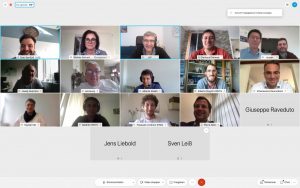
On October 7th, during the Kick-Off Event for the Smart Energy Competence Centre the IDEASFORUM team discussed and evaluated the following list of possible future areas of activity.
- Increase awareness on standardisation initiatives relevant for cross-domain development (eg, GAIA-X, International Data Spaces Association, X-Road, eID NRW, cybersecurity to protect customers’ accounts, etc).
- The IDEASFORUM Community should contribute to build and cooperate with research institutions and look at the establishment of a Research & Innovation Alliance, to catalyse and streamline innovation efforts in its competence areas.
- The IDEASFORUM Smart Energy Competence Centre should take an active role in supporting and promoting initiatives for the development of micro-grid concepts in line with the formalised role of Local Energy Communities – Directive (EU) 2019/944 and assure that the discussion on regulatory changes, governance models and service oriented architectures makes significative progresses.
- The IDEASFORUM Smart Energy Competence Centre should actively participate to the work of the FIWARE Foundation and Linux For Energy Program (LFE) on Smart Data Models to support the deployment of future digital energy services.
The work on all these streams have already started and several individuals and organisations have expressed support and initiated engaging with the work of the working groups.
Should you or your organisation be interested to join our Smart Energy Competence Center and its working groups, please send us an email info@ideasforum.org
CEF Success story published – How Context Broker is helping Europe in its quest for smarter energy solutions
The Connecting Europe Facility Digital Team has published a Success story on how the use of FIWARE technologies powering the Context Broker building block can support the development of microgrid services and support the implementation of smart energy applications in local energy communities.
Please access the article from here.
Recording of the first Smart Energy virtual MeetUp
The recording and presentation from the first virtual MeetUp of IDEASFORUM, organised with the support of the Team of Prof Monti at the University of Aachen RWTH are now available from the links below.
Presentation Smart Energy Competence Center20201005
IDEASFORUM becomes part of the big FIWARE iHubs family
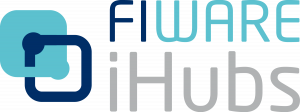
It is with pride that we announce IDEASFORUM has become part of the family of the FIWARE iHubs.
“This achievement strengthens our determination to work closer to the FIWARE Community in bridging the differences and filling the gaps which have prevented digitalisation to reach all parts of society.”.
The challenge for digital transformation in public administration (article from Joao Frade, EC – DIGIT)

The IDEASFORUM Team happy to share with you this insightful piece from Joao Frade, who is coordinating efforts of the CEF Digital team.
The SARGON (Smart eneRGy dOmain oNtology) Ontology
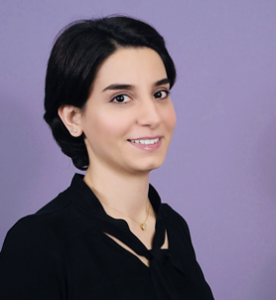
The world of IoT is a scattered landscape characterized by a plethora of standards, platforms and technologies, often siloed into different vertical domains, very often unable to communicate to each other.
The Energy Industry cannot afford to continue being fragmented and it is becoming evident at different levels of the value chain that a protocol- independent semantic layer that can serve as interoperability enabler among different categories of smart devices (which could be co-existing in a specific industry domain, or even operate across different domains) coming from different manufacturers. To achieve this level of interoperability, in 2015 industry and academia decided to work together and drafted the SAREF ontology, with the objective to assure data interoperability, enabling communication between IoT devices using different protocols and standards. A number of industrial players operating in different sectors, after testing and assessing the potential of the ontology, expressed their interest to extend SAREF into other domains, in order to fill the gaps in the semantics not yet covered by their communication protocols. As a result of these initiatives, the framework of the SARGON (Smart eneRGy dOmain oNtology) ontology was drafted and used to extend SAREF for achieving better monitoring and controlling in applications to digitize Smart Grids and implement Building Automation projects. The SARGON ontology is based on several existing industry standards and the work of IoT standardization initiatives, as well as on real use cases. It includes classes, properties and instances specifically created to cover the various categories of devices possibly deployed in Smart Energy infrastructure.
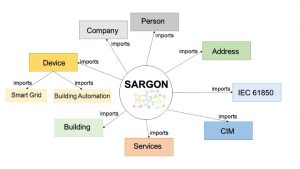
The image above gives a possible picture of the complexity for such a fragmented information domain and all of its components are gathered in the SARGON ontology, which aggregates all these cross-cut domain-specific information.
In addition to this, one of the other major advantages of the SARGON ontology is its modularity, which allows further development of new elements necessary to fill possible gaps and supports any additional development of missing information models, allowing properties and relationships to receive better descriptions, adding additional levels of properties and relationships.
IDEASFORUM is hosting Malileh Haghgoo on October 21st in a Tech-pill focused on introducing the SARGON Ontology to developers of smart energy applications.
Please register here
To access IDEASFORUM Eventbrite page, please click here
IDEASFORUM kicks-off its operations
Yesterday, Sep 15th, the promoters of the IDEASFORUM Innovation Hub met in a virtual event hosted by Umagine where members of 18 different organisations discussed on the future goals of the initiatives.
Ulrich Ahle, CEO of the FIWARE Foundation and other members of the Board of Directors joined the event.
The various teams of experts on competence areas will meet in the next few weeks for their internal kick-offs, while the first of the IDEASFORUM public virtual events is scheduled for October 5th, with a presentation on the use of FIWARE generic enablers in smart energy applications (please register here)
.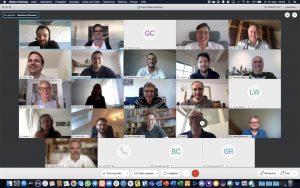
Coronavirus: Commission starts testing interoperability gateway service for national contact tracing and warning apps
To exploit fully the potential of mobile proximity contact tracing and warning apps to break the chain of coronavirus infections and save lives, the Commission is setting up an interoperability gateway service linking national apps across the EU. Today, an important milestone has been reached as a group of Member States starts testing the infrastructure. The Commission has kicked off test runs between the backend servers of the official apps from the Czech Republic, Denmark, Germany, Ireland, Italy and Latvia, and a newly established gateway server.
Leave your mark on the upcoming FIWARE Domain DAYS

We are all set for the FIWARE Domain DAYS in September but there is still time to get involved in the October, November, and December virtual events. The Domain DAYS provide a fantastic opportunity for our community to showcase the role of Open Source in a variety of relevant FIWARE domains (all of which you can see in the box below), with keynote and specialist speeches, as well as top-notch use cases from across the globe. Do you feel like you have an interesting angle to tap into, a great FIWARE-powered use case to present, or experiences you think would be valuable to share with the audience? Get in touch with the FIWARE Marketing Team so we can discuss how best to accommodate your contribution.
Upcoming FIWARE Domain DAYS
Become a certified FIWARE Expert

FIWARE Foundation is planning to conduct a set of #ExpertExams on 24 September (TBC). For this, and future Expert Exams, we are looking to work together with interested parties (e.g. iHubs, Gold Members) to provide examiners and candidates. Interested in teaming up? Please get in touch with Charlotte Kotterman.
Have you made a solid recognized contribution to the FIWARE Community? Do you have a thorough cross-chapter understanding of all aspects of FIWARE including the latest developments in the catalogue? Can you describe how to architect FIWARE-based solutions properly at scale? If you were able to answer all of those questions with a definite “yes”, and you wish to be recognized by your peers in the FIWARE Community as an acknowledged expert, then sign up for the FIWARE Experts Certification Program and take the Expert exam.
2nd CEF eTranslation Conference: Tools and Services for a Multilingual Europe, 14/10

This virtual conference will explore the topic “Tools and Services for a Multilingual Europe”, showcasing smart eTranslation applications and the latest tools for enabling multilingualism.
In English
Once Only Principle Project Web Conference, 23/09

This event will present the project achievements in piloting the once-only principle and will also focus on the handover of the TOOP project solutions to a CEF Preparatory Action.
In English
CEF eArchiving webinar: DBPTK – an eArchiving solution for database archiving, 24/09

This webinar will allow you to better understand the issues involved when preserving databases and overarching information systems and discover the different preservation strategies that apply to databases and the pros and cons of each.
In English
CEF Context Broker and BDTI webinars, 24 & 29/09

The CEF Digital Team is organising a virtual event on how Context Broker and Big Data Text Infrastructure integrate to build data driven applications. Learn how the Context Broker and BDTI Building Blocks help you make sense of the data available through your city’s information systems, and make the right decisions to improve the public services you offer to your citizens.
In English
Some Thoughts on the Digital Transformation of Public Services.

Steve Jobs, October 7, 2011
“Technology alone is not enough. It’s technology married with the liberal arts, married with the humanities, that yields us the results that make our hearts sing.”
I decided to start with Steve Job’s quote the second part of my attempt at sharing “experiences” on the digital transformation of the Public Sector (See The arduous path towards a “Smart City” … Aesop’s “The Fox and the Grapes” reloaded?), considering how his approach to innovation has changed our way of looking at the World of Consumers’ Technology in the last few years.
Since Steve Job’s premature passing, many Tech giants have been following his path and reinforced, in their product development teams, those areas focused on better understanding human behaviors and translate their studies in “more engaging”, “pervasive” and “relevant” (for the users) user experiences.
Companies focused on “Consumer Electronics” and the ICT Industry, have been chasing and confronting with Apple’s philosophy, refocusing resources and attention to how people uses technology, but also to the way technology could be made available to humans in order to solve their daily issues.
In other words, there has been an enhanced focus on assessing use cases on their “mass dimensions”, by introducing sociology, psychology and behavioral sciences in general as part of the development process of technological solutions, with the result of embedding them more tightly in our daily lives, in some cases heavily changing behavioral and social models (consider the impact of mobile smart-phones and apps on a global scale).
These considerations bring me to the question, that is, if we could consider applying this “behavioral” approach to the so called “Digital Transformation of Public Services“, in order to support and sustain change management projects aimed at implementing digital citizenship as part of a digitized society.
The Impact of the “Skills Gap” on Digital Transformation
Through the Digital Transformation of the way we do things, both in the Private and Public Sectors, we are hoping to change our society for the better. But for sure we have to admit that there are a number of negative implications and “side effects”, which are undesired “guests” at the table and, if not properly handled, insurmountable obstacles to achieve our goals.
And while the need of applying proper “change management” practices are “buzz-wordily” on the mouth of anybody who is part of the discussions on the “How-To’s” of Digital Transformation, on the other end, there is general consensus in identifying a broad Technological “Skills Gap” as one of the main root causes for this “lethargy”.
When talking to friends and professionals on the “techies-side” of the “digitization barricades”, it is common to hear them expressing their frustrations about the difficulties to collect, refine and finalize “specifications” necessary to design the new digitized business processes, very often implying that this situation is a consequence of the limited technical skills of their counterparts.
Being an “insider”, I cannot disagree with this view, especially looking at the broader definitions of skills gap given not only by the ICT Industry, but also by Academia, Analysts, etc and which I could summarize in the following: “A Skills Gap is defined as “a significant gap” between an organization’s skill needs and the current capabilities of its workforce.”
Especially when looking at the Public Sector, it is true that, because of tight and shrinking budgets, particularly “strict” labor regulations for public employees and a constantly aging population in western societies, it is very difficult to close some of these gaps with training, job rotations and other usual practices, especially when the required skills are deeply rooted into innovative and rapidly developing technological environments and require highly specialized workforce (the European Commission has addressed this in its study on “The Digital skills gap in Europe“, providing a clear pictures of the situation across EU Member States).
How to Mitigate these Risks and Reduce these Obstacles?
Acknowledging the problem, European Institutions have been steadily working in supporting businesses and public administration in reducing complexity of digital transformation of Industries by defining and promoting new “standards”, funding R&D and participating to pilot initiatives (e.g. through the Horizon 2020 Program), fostering the establishment of “common knowledge” and “best practices” sharing platforms.
On the other end, the ICT Industry seems to be moving in an extremely factual way, focusing on facilitating transformation by using new techniques to leverage on the assets represented by experienced employees (namely their knowledge of processes, policies and governance models) and moving towards platforms more focused on integrating processes, building knowledge across the organization and leverage on “best practice based” configurable interfaces.
More intriguingly, learning from best practices at Consumer Electronics giants, many Government bodies and ICT players are now systematically applying agile development, design thinking (cifr. C. Bason, Leading Public Sector Innovation: Co-creating for a Better Society) and behavioral sciences as methodologies to facilitate the transformation (into their digital “equivalent”) of processes established for the delivery of public services.
The main driver of these new approaches is the realization that the engagement of stakeholders (the public employees) in the rapid prototyping of subsequent tasks/phases of the redesign projects, is a real game changer, allowing technical experts and process experts to “discover” together how to better translate the analog world into its digital representation.
On one end, the civil servants involved in the delivery of the service appreciate that, with their direct engagement in the rapid prototyping phases, the peculiarity of their daily work is “valued” by the team they become part of, their concerns shared and more deeply understood by the developers, while on the other, the developers are able to concretely represent the progresses of the change team work and show, through the rapid prototyping of functionalities, what the real benefits of digitalization are.
In essence, the introduction of “transparency” as the key innovation driver of thedevelopment phase allows translating the codification of specifications into a “discovery journey” which could assure higher acceptance rates and a “final product” built not only on exploiting available technical features, but also on an improved user experience more in line with the expectations of the prime users (internal customers), the civil servants who will be called to deliver the new digital services.
This way, “change” is not anymore imposed on public sector employees, who become an active, positive driver of the transformation itself.
I was amazed by reading that companies like Deutsche Bahn are now actively engaging with their staff leveraging on agile approaches focused on the use of “rapid prototyping” in process redesign and process development cycles, while tech giants like IBM, are actively employing with their public sector customers “design thinking” techniques to accompany their customers’ employees in a discovery journey of how technology can be used to improve processes from the ground up. And this just to quote a number of examples.
There’s a way to do it better, … find it!
Thomas Edison
In conclusion, assuring a tighter level of inclusion and transparency, resulting in a stronger engagement from stakeholders in the past too often excluded from these projects, there is the chance to mitigate the risks of “resistance” to change caused by “fear of the unknown”, or by the difficulty to abstract from daily tasks, or even worse, by the unanswered questions on the benefits derived from digitalization (“digital” is not there to replace human beings, but to help them doing their job better!).
And it is a good feeling to realize how, thanks to this innovative blending of technology, behavioral sciences and design thinking, such promising results can be achieved in the deployment of new digital technologies for the delivery of public services (see S. S. Dawes, A. M. Cresswell, T. A. Pardo, “From “Need to Know” to “Need to Share”: Tangled Problems, Information Boundaries, and the Building of Public Sector Knowledge Networks”).
The arduous path towards a “Smart City” … Aesop’s “The Fox and the Grapes” reloaded?

“Oh, you aren’t even ripe yet!” … said the fox “I don’t need any sour grapes.”
You will forgive the arrogance of posting my thoughts on this platform, but I have spent the last few years of my professional life trying to make some sense out of the continuous buzz-wording around “Digital Transformation” of the Public Sector (here we go with the first abused buzz-word) and in particular in the area of the so called “Smart Cities” (“errare humanum est, … perseverare diabolicum”, Seneca wrote), that I hope I can contribute to the discussion by sharing some of my thoughts and experiences.
First of all a few words on myself, just to put things into context. I come from a humanistic background, but I spent the last 10 years in “Technology”, trying to bring innovation into new markets and business models.
In the last 5 years I had the chance to spend most of my time in studying, assessing and implementing IOT solutions to support the digitalization of local Public Administration and “Utility” Companies, having often the privilege to sharing thoughts, ideas and concerns with politicians (… representing communities big and small), public administrators, managers of the IT & ICT infrastructures of those Authorities and many IT & ICT “industry players”.
This said, the “intellectual turmoil” leading to this “explosion” (this article) derives from recent events of the last few months, just after I left my position in one of the major European ICT players and joined a Public Institution (where I continue to focus on “efficiency” and digital transformation), events culminating in the realization of the gap, the still “un-bridged” distance, between the ways of Public Institutions and the ones of Technology players.
While it is undeniable that giant leaps forward have and are being made, every day, in building solid foundations to effectively digitalize entire public service areas (and in some fields the digitalization is already under way, or has even been partially completed), it is also true that there is still much to do to make replicability, scalability and affordability part of the DNA of these technological solutions.
The vast majority of “smart city” projects (even if there are many, intensively advertised ones, which are undoubtedly successful), unfortunately, seems to remain anchored to proof of concepts, pilots and small scale testing environments, very often limited to “theatrically stage” how technologies (or cosmetically customized versions of their applications) operate in “real-life”.
If you are skeptical about these first statements, just try to enter in a search engine the combination of words “smart city failures” and you will be amazed by the quantity and quality of the available content.
The question that raises from these considerations is why it is so difficult to move to the “next level”, i.e. the full rollout of a technological infrastructure to digitalize the provisioning of a public service to citizens.
And in addition to this, why is it, in the majority of instances, that moving from “pilot state”, seems to be a titanic challenge, with both parties (the Public Sector and the ICT “Industry”) very often unable to proceed together in their efforts towards full-scale digitalization?
Building a Theoretical Model
Here comes a theory (of which limitations and approximations I take full responsibility), based on the observation of the moods, motivations, aspirations, “clichés”, frustrations, from both sides of the barricades.
Using an oversimplified graphical representation of the “decision making” framework in which public administrators and executives of technology companies are tasked to operate, let’s try to elaborate on its implications.
The first point which takes the attention is the role given to what I indicate as “Policies“. Policies are the programmatic framework, the political platform on which public administrators are elected to office. During the elections campaigns, these sets of political objectives are the topic of discussion with constituents and represent the “strategic program” to which officials should be adhering during their electoral mandate.
So, why not calling this “Strategy”, instead of “Policies”, as academia and consulting usually do? For the simple reasons that, while strategies in corporations (“for profit organizations”) have as ultimate objective a “profitable” outcome of the organization’s endeavors, even in contexts where “social responsibility” is becoming more and more a driver in consumers’ loyalty (“profit“), a Public Local Administration (“non-profit” organization) will systematically target the implementation of social and political objectives and not pursue profit.
This passage is fundamental in understanding the stall in which some smart city initiatives are languishing and why “scaling” up of lab tests, proof of concepts and pilots appears often so arduous.
While the “Industry” usually blames this state of things on the political side (e.g., the skill gaps in the IT departments, the “magmatic change” of mood in decision makers, not enough focus on innovation, etc) the reality is that, too often, Technology organizations are failing to apply to these projects basic business principles.
And in too many cases, these Industry players seem not to be paying attention to the details of the “use cases” they are tackling and, even more often, they are unable to understand how Public Authorities’ operational and organizational models are affected by the programmatic Policies of the Public Institutions they are part of.
Visualizing to reduce complexity
Let me explain with a couple of charts how a public organization could be assessing technologies promising to provide new services to its community. But please be aware that this approach is just an exemplification and has no ambitions to design a “model” or being en exhaustive, “magic” tool to identify procedures for selecting technological solutions.
First and foremost, given the principles introduced by the new European Procurement Directive 2014/24/EU on Public Procurement, the total cost of operating the technological solution during the period of the assignment contract (total cost of ownership – T.C.O.), is now clearly identified as one of the drivers which should be part of the tender evaluation.
As a consequence, when benchmarking and comparing alternative “smart city” solutions, the T.C.O. better than the mere “purchasing cost” should be assessed versus the “technical value/content” of a solution, measured in terms of relevant technical features (relevant for the purpose of delivering the desired service to the community).
The chart below oversimplifies this process, which would end in ranking solutions in terms of value (available technical features) for money (the total cost of operating the solution).
This and similar benchmarking techniques could be the starting point for deciding to enter into a proof of concept.
But this is also where many Technology Organizations are systematically missing the opportunity to “learn” how to match their product portfolio (the set of standardized use cases they have “packaged”) with the “use case” at hand.
In my experience, this is due to the inability of exploiting the opportunities to learn fromthe environmental constraints and the feedback coming from public officials on what lays beyond the “use case”, i.e the social, political and “local economic interests” the provisioning of the service should be affecting.
The following chart should help visualizing, once again by oversimplifying the benchmarking process, how these social, political and local economic interests (usually “programmatically” addressed in a Policy document), could impact the decision towards a solution that maybe does not rank at the top of the previous assessment, but shows a much better fit to the Community objectives, like supporting local businesses, boosting new commercial/residential development areas, promoting social integration by supporting specific “economically underdeveloped” communities, etc.
In the chart, the dimension of the bubbles represents a different angle to assess the relevance of the solution from a social and political perspective, or with relation to the impact on the “local economy”.
As a consequence of this analysis, we could find ourselves in a situation for which a solution with, e.g. the lowest “technological” value (lower number of assessed technical features) would be the preferable one, as it maximizes the benefits from the Policy perspective.
For sure, to make the benchmarking more accurate, the weight of the programmatic policies objectives could be “pondered’ and weighted with relation to a priority ranking of those objectives, once again potentially changing the reading key of the assessment.
Different alternative techniques and tools could be applied to perform this exercise, so please allow me to remind you that is not my purpose to provide a “magic model” applicable to each and every case, but mainly to stimulate the readers intellectually and encourage them to adjust these principles to their specific case.
Conclusions
What emerges from these considerations, is that, if this model comes only close to explaining how decision could be (or should be) taken in the context of “digital transformation” of public services, very probably it won’t be technology to drive the decision of adopting a specific architectural model, but the way technology can be used to implement the above-mentioned programmatic Policies objectives.
In such a context, it becomes easier to understand why Technology brands are often finding difficult adjusting their strategies to the needs of this “market”.
If you are an executive in the Hi-tech industry and try to differentiate from competition by adding unicity to your technological portfolio, you usually do it by leveraging on your main assets, being them your IP (Intellectual property), your “interpretation” of technology (the flavor, the mix of features that builds the “user experience” you envisioned for your customers), your ability to correctly placing your products at the right “price” in the marketplace (economics), or the level of quality and grade of stability achieved in your product portfolio (usually granted by the set of skills you have been able to aggregate in your organization, by attracting talents), etc.
But, when you are facing possible “customers” who are re-shaping the ranking of your values, by prioritizing social, political and “partisan” (support to local economy), aspects that you usually consider more as environmental constraints, either you become able to design new processes and strategically adjust your portfolio to those values (by adapting “your” use cases to match the “ones” targeted by the public institution), or you will find extremely difficult to be successful.
That’s probably one of the main reasons why smaller organizations and start-ups (focused on niche “solutions”) seem to be more “fit” than Tech giants in matching use cases designed on the operational and organizational models through which Public Authorities are traditionally operating.
For sure, these smaller players are more agile, adaptable, but also and foremost, they act “locally”, very often starting from a “system integration” background, which allows them to look at the customer’s use case (what really needs to be done, without the bells & whistles) with a different attitude.
In essence, they are able to focus on the use case at hand, instead of proposing a “one size fits all” interpretation of that use case, which too often does not match at all with the one “on the ground”.
The major drawback of this state of things, is a known issue in the discussion around “smart cities” and lays in the difficulty of scaling up these tailored “solutions” and leveraging on possible economies of scale to make these projects “industrialized” and replicable in other contexts.
Industrialization, replicability and facilitating economies of scale are the fields where, for the benefit of us all, some major ICT players seem to be finally steering their focus.
In fact, as an example, some of the big “Telco” Companies have started building “environments” in which they are actively partnering with these more agile, smaller but innovative organizations, providing them with “reusable” technological components, economical and technical support, guidance on matters like cyber-security, etc, in order to assure that their future solutions are accessible, sometime more visible, but in particular more affordable to public authorities engaged in digital transformation.
But these commendable efforts are not the rule and, in my humble, personal experience, too many Technology organizations have withdrawn from the arena, not being able to keep the promises of miracle profits to their shareholders, justifying these decisions with considerations on a market “not yet mature”, stating the obvious “Oh, you aren’t even ripe yet! I don’t need any sour grapes!“.




